The next-gen MacBook Pro with Retina Display Review
by Anand Lal Shimpi on June 23, 2012 4:14 AM EST- Posted in
- Mac
- Apple
- MacBook Pro
- Laptops
- Notebooks
Last year when I wrote about the new MacBook Airs I offered two forward looking paragraphs:
What happens from here on out is what's really interesting. Intel has already committed to moving the TDP of its mainstream parts from 35W - 45W down to 10 - 20W. Since the Air is the new mainstream Mac notebook, Apple has already made that move. The performance in this 10 - 20W segment is going to get much better over the next two years, particularly once Haswell arrives.
The Thunderbolt Display is the first sign of what's to come. Moving IO controllers and expansion into the display, and potentially even moving discrete GPUs out of the notebook are all in store for us. Apple is really ahead of the curve here, but it's easy to imagine a future where laptops become a lot more like the new Air and shift to a couple high bandwidth ports instead of numerous lower bandwidth connections.
Perhaps I was being too aggressive in the prediction of a couple of high bandwidth ports. After all, the next-generation MacBook Pro with Retina Display features four such IO ports (2 x Thunderbolt and 2 x USB 3.0). But you get my point. Gigabit Ethernet and Firewire 800 are both gone. The discrete GPU is still present but I suspect even its days are numbered, at least inside the chassis. The personal computer as we knew it for so long, is changing.
The personal computer is getting thinner, lighter, more integrated and more appliance-like. The movement is no longer confined to just Apple either. The traditional PC OEMs are following suit. Even Microsoft has finally entered the PC hardware business, something it threatened to do for years but hadn't until now. Distribution models will change, the lines between different form factors will continue to blur. What was once a mature industry is going through a significant transformation. It’s exciting but at the same time it makes me uneasy. When I first got into this industry everyone had stories of companies with great ideas that just didn’t make it. As we go through this revolution in computing I’m beginning to see, first hand, the very same.
Apple makes the bulk of its revenue from devices that don’t look like traditional personal computers. For the past couple of years I’ve been worried that it would wake up and decide the traditional Mac is a burden, and it should instead be in the business of strictly selling consumer devices. With its announcements two weeks ago in San Francisco, I can happily say that my fears haven’t come true. At least not yet.
It’s been a while since Apple did a really exciting MacBook Pro launch. Much to my surprise, even the move to Sandy Bridge, the first quad-core in a MacBook Pro, was done without even whispers of a press conference. Apple threw up the new products on its online store, shipped inventory to its retail outlets, updated the website and called it a day. Every iPhone and iPad announcement however was accompanied with much fanfare. The MacBook Pro seemed almost forgotten.
With its WWDC unveil however Apple took something that it had resigned to unexciting, dare I say uncool status, and made a huge deal about it. Two weeks ago Apple did the expected and offered relatively modest upgrades to all of its portable Macs, all while introducing something bold.
Apple calls it the MacBook Pro with Retina Display. You’ll see me refer to it as the next-gen MacBook Pro, Retina MacBook Pro, rMBP or some other permutation of these words.
After using it for the past two weeks I can honestly say it’s the best Mac Apple has ever built. And there’s a lot more to it than hardware.
Portability
If you were hoping for a 15-inch MacBook Air, that’s not what the rMBP is. Instead it is a far more portable 15-inch MacBook Pro. I have to admit I was a bit let down the first time I laid eyes on the next-gen MacBook Pro, it looks good but it doesn’t look all that different. The disappointment quickly faded as I actually picked up the machine and started carrying it around. It’s not ultra light, but man does it make the previous chassis feel dated.
While I never really liked lugging around the old MBP (and it always made me feel like the old fogey at tradeshows where everyone else had something 13-inches or smaller), carrying the rMBP is a pleasure by comparison. Pictures really don’t do it justice. The impressively thin display assembly or overall chassis thickness look neat in a photo but it’s not until you actually live with the rMBP that you can appreciate what Apple has done here. I carry around a 15-inch MacBook Pro because it’s my desktop, and as such it’s incredibly useful to have with me when I travel. For my personal usage model, the Retina MacBook Pro is perfect.
If your workload demands that you need the performance of a MacBook Pro and your lifestyle requires you to carry it around a lot, the reduction in thickness and weight alone will be worth the upgrade to the rMBP. If you spend most of your time stationary however, you’ll have to be sold on the display and internal characteristics alone. The bad news is if the design doesn’t get you, everything else will.

From left to right: 11-inch MacBook Air, 13-inch MacBook Air, 15-inch MacBook Pro, MacBook Pro with Retina Display
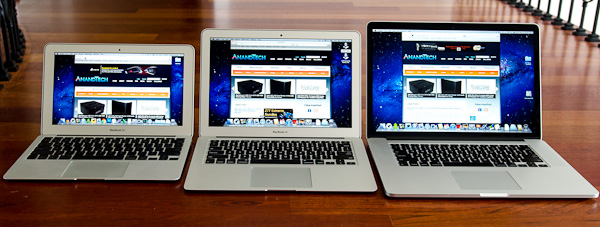
From left to right: 11-inch MacBook Air, 13-inch MacBook Air, MacBook Pro with Retina Display
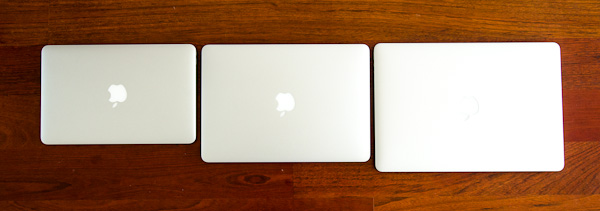
From left to right: 11-inch MacBook Air, 13-inch MacBook Air, MacBook Pro with Retina Display


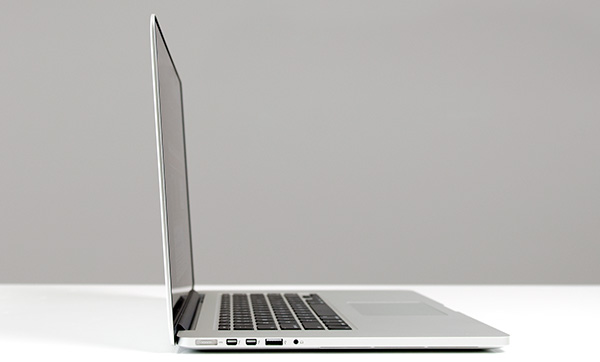
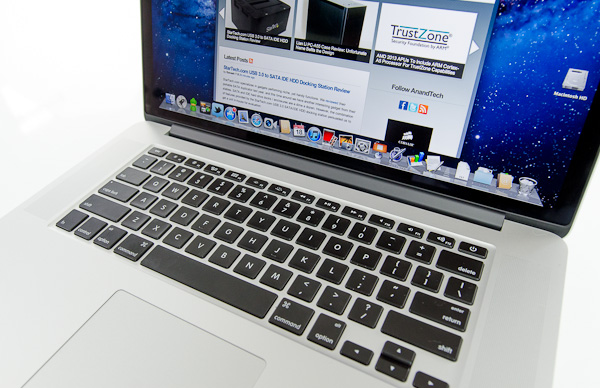
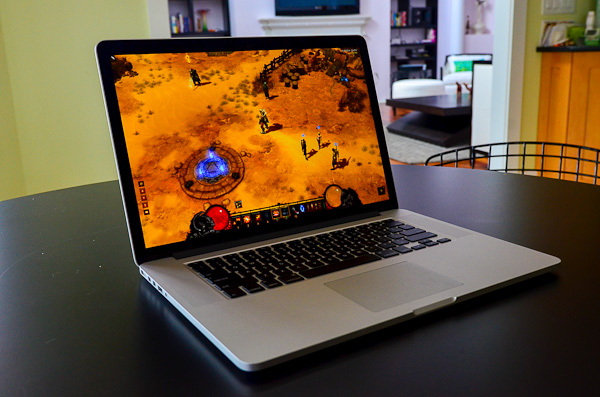
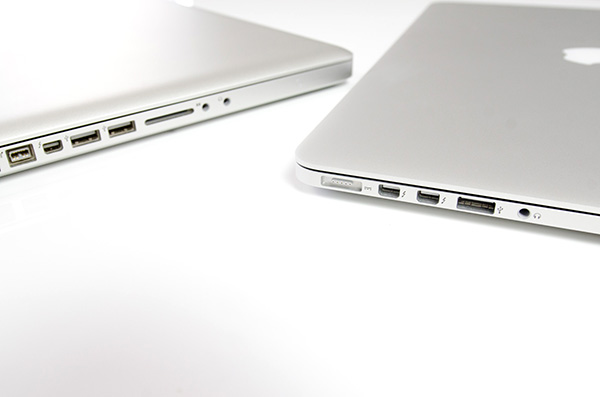
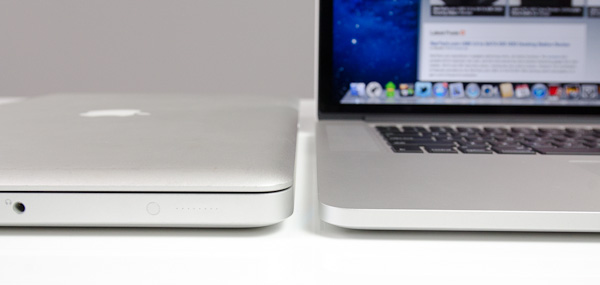








471 Comments
View All Comments
wfolta - Saturday, June 23, 2012 - link
There are only three thermals facts that matter, and the article covers all three:1. Does heat throttle performance (CPU, GPU)?
2. Does heat make it uncomfortable to use?
3. How intrusive/annoying are the fans used to cool it?
tipoo - Sunday, June 24, 2012 - link
Agreed with wfolta, the review does have temperature data for different parts of the surface, and it does show that it does not throttle performance due to temperature over time, both of which have more real world significance.EnerJi - Saturday, June 23, 2012 - link
Haven't read the article yet, just wanted to say we've been anxiously waiting weeks for AnandTech's definitive review. Can't wait to carefully review over the weekend. Thanks!TheTruthHurtsSoMuch - Saturday, June 23, 2012 - link
So, where are the thermal readings from the case? How can you have an entire section devoted to thermals and omit reading any temperatures? It's insulting to me.ciparis - Saturday, June 23, 2012 - link
1) There are case temperature readings in the review.2) Insulting? Really? Stop acting like an entitled twit, you unappreciative, non-contributing zero. </Lewis C.K.>
TheTruthHurtsSoMuch - Saturday, June 23, 2012 - link
1) You're right, it appears to have been edited in, I can now see two readings, 49.8C (top) and 41.8C (bottom), rather useless without idle temperatures, but OK it is something, though close to nothing. Three other commenters supports this conclusion, this is what they had to say about temperatures:"How come that the part "Vastly Improved Thermals" comes with no data about surface temperatures?"
- nikolayo
"dont forget he also [ed: note also] doesnt supply any data for the improved noise"
- ringgix
"I don't think you can conclude or suggest that there are "vastly" improved thermals without even using a tool that measures temperatures in comparison to a baseline. That entire page talks more about noise characteristics than "thermal" performance."
- Megatran
2) Yeah, it is. Same as for monitor reviews that "forget" to mention anything about AG coating. The message is that you shouldn't worry your little head about dirty, shimmering displays. Same as is in this review then, because this laptop is so hot (50c) it will melt your balls and scorch your fingers.
Maybe you're to bedazzled by the "review" to care.
Taft12 - Monday, June 25, 2012 - link
Someone capable of such condescension must have quite a list of more comprehensive tech reviews than this one. Care to share a few? If this "review" is worthy of quotes, I'd love for you to link a few that are not.iwod - Saturday, June 23, 2012 - link
For years we have been crying for something like SSD, I/O were our bottlenecks, because most of our Day to day usage like internet browsing and simple editing of images and documents are not bound by CPU or GPU. But all of a sudden with 4x the pixel and possibly many more times the calculation complexities, we are back to square one again.If Apple really wanted the GPU and CPU in 1 Silicon, the GPU inside would have to be better then the current Geforce 650M, Intel 4000HD is at least 2 - 4x away from it.
And on Pricing. I am surprised NO a single reviews talks about the pricing between rMBP and Top Model MBP. They are the same price, but you get a IPS Retina Display and 256 SSD, both worth more then Non Retina Crappy TN Display and 750GB HDD, Unless you really wanted something on the Old Design there is absolutely no way anyone would buy the MBP Top Model.
ananduser - Saturday, June 23, 2012 - link
It's about limiting choice to protect their lineup. The retina mb will not gain traction if you could spec a similar machine, sans the panel, and pay significantly less in the process.javipas - Saturday, June 23, 2012 - link
By far, the best I've seen anywhere. Congrats for your hard work, Anand. I've tested the rMBP myself and I have some doubts about several areas -screen resolution choices, upgradeability/repairability, and price/configuration choices- but overall the rMBP represents an impressive leap not only for Apple, but for the whole PC industry.In fact, As you've said high resolution displays are possible the next big move by hardware vendors on the next few years. Haswell and its sucessors (let's see if AMD can make a difference with their Fusion APUs) promise a lot too, so I think the rMBP is easily the most revolutionary product in the laptop market in years.
Again, thanks for a formidable read.